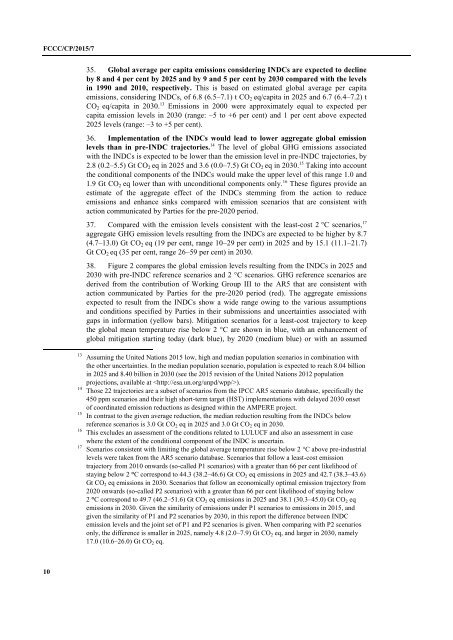FCCC/CP/2015/7
1PYuHQM
1PYuHQM
You also want an ePaper? Increase the reach of your titles
YUMPU automatically turns print PDFs into web optimized ePapers that Google loves.
<strong>FCCC</strong>/<strong>CP</strong>/<strong>2015</strong>/7<br />
35. Global average per capita emissions considering INDCs are expected to decline<br />
by 8 and 4 per cent by 2025 and by 9 and 5 per cent by 2030 compared with the levels<br />
in 1990 and 2010, respectively. This is based on estimated global average per capita<br />
emissions, considering INDCs, of 6.8 (6.5–7.1) t CO 2 eq/capita in 2025 and 6.7 (6.4–7.2) t<br />
CO 2 eq/capita in 2030. 13 Emissions in 2000 were approximately equal to expected per<br />
capita emission levels in 2030 (range: –5 to +6 per cent) and 1 per cent above expected<br />
2025 levels (range: –3 to +5 per cent).<br />
36. Implementation of the INDCs would lead to lower aggregate global emission<br />
levels than in pre-INDC trajectories. 14 The level of global GHG emissions associated<br />
with the INDCs is expected to be lower than the emission level in pre-INDC trajectories, by<br />
2.8 (0.2–5.5) Gt CO 2 eq in 2025 and 3.6 (0.0–7.5) Gt CO 2 eq in 2030. 15 Taking into account<br />
the conditional components of the INDCs would make the upper level of this range 1.0 and<br />
1.9 Gt CO 2 eq lower than with unconditional components only. 16 These figures provide an<br />
estimate of the aggregate effect of the INDCs stemming from the action to reduce<br />
emissions and enhance sinks compared with emission scenarios that are consistent with<br />
action communicated by Parties for the pre-2020 period.<br />
37. Compared with the emission levels consistent with the least-cost 2 °C scenarios, 17<br />
aggregate GHG emission levels resulting from the INDCs are expected to be higher by 8.7<br />
(4.7–13.0) Gt CO 2 eq (19 per cent, range 10–29 per cent) in 2025 and by 15.1 (11.1–21.7)<br />
Gt CO 2 eq (35 per cent, range 26–59 per cent) in 2030.<br />
38. Figure 2 compares the global emission levels resulting from the INDCs in 2025 and<br />
2030 with pre-INDC reference scenarios and 2 °C scenarios. GHG reference scenarios are<br />
derived from the contribution of Working Group III to the AR5 that are consistent with<br />
action communicated by Parties for the pre-2020 period (red). The aggregate emissions<br />
expected to result from the INDCs show a wide range owing to the various assumptions<br />
and conditions specified by Parties in their submissions and uncertainties associated with<br />
gaps in information (yellow bars). Mitigation scenarios for a least-cost trajectory to keep<br />
the global mean temperature rise below 2 °C are shown in blue, with an enhancement of<br />
global mitigation starting today (dark blue), by 2020 (medium blue) or with an assumed<br />
13 Assuming the United Nations <strong>2015</strong> low, high and median population scenarios in combination with<br />
the other uncertainties. In the median population scenario, population is expected to reach 8.04 billion<br />
in 2025 and 8.40 billion in 2030 (see the <strong>2015</strong> revision of the United Nations 2012 population<br />
projections, available at ).<br />
14 Those 22 trajectories are a subset of scenarios from the IPCC AR5 scenario database, specifically the<br />
450 ppm scenarios and their high short-term target (HST) implementations with delayed 2030 onset<br />
of coordinated emission reductions as designed within the AMPERE project.<br />
15 In contrast to the given average reduction, the median reduction resulting from the INDCs below<br />
reference scenarios is 3.0 Gt CO 2 eq in 2025 and 3.0 Gt CO 2 eq in 2030.<br />
16 This excludes an assessment of the conditions related to LULUCF and also an assessment in case<br />
where the extent of the conditional component of the INDC is uncertain.<br />
17 Scenarios consistent with limiting the global average temperature rise below 2 °C above pre-industrial<br />
levels were taken from the AR5 scenario database. Scenarios that follow a least-cost emission<br />
trajectory from 2010 onwards (so-called P1 scenarios) with a greater than 66 per cent likelihood of<br />
staying below 2 °C correspond to 44.3 (38.2–46.6) Gt CO 2 eq emissions in 2025 and 42.7 (38.3–43.6)<br />
Gt CO 2 eq emissions in 2030. Scenarios that follow an economically optimal emission trajectory from<br />
2020 onwards (so-called P2 scenarios) with a greater than 66 per cent likelihood of staying below<br />
2 °C correspond to 49.7 (46.2–51.6) Gt CO 2 eq emissions in 2025 and 38.1 (30.3–45.0) Gt CO 2 eq<br />
emissions in 2030. Given the similarity of emissions under P1 scenarios to emissions in <strong>2015</strong>, and<br />
given the similarity of P1 and P2 scenarios by 2030, in this report the difference between INDC<br />
emission levels and the joint set of P1 and P2 scenarios is given. When comparing with P2 scenarios<br />
only, the difference is smaller in 2025, namely 4.8 (2.0–7.9) Gt CO 2 eq, and larger in 2030, namely<br />
17.0 (10.6–26.0) Gt CO 2 eq.<br />
10


